The multi-photon microscopic system market is forecasted to expand from an estimated USD 201.2 billion in 2025 to USD 330.8 billion by 2035, reflecting a steady CAGR of 5.1%. This growth trajectory is supported by increasing demand in biomedical research, drug discovery, and neuroimaging applications, driven by advances in imaging technology and precision medicine.
The market’s consistent upward movement over the forecast period indicates strong adoption of multi-photon microscopy across research institutions and healthcare facilities globally. This expansion is driven by growing investments in advanced microscopy, rising R&D spending, and enhanced imaging requirements for complex biological tissues.
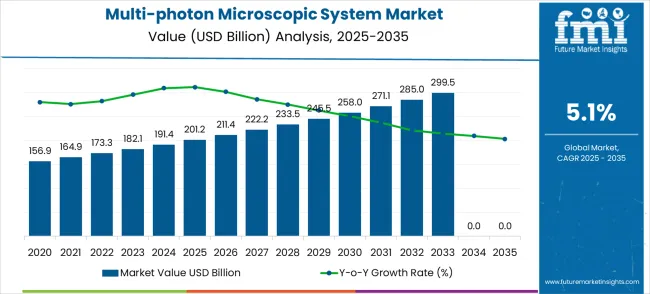
Analyzing year-on-year (YoY) growth reveals steady annual increases, with no significant dips. From USD 201.2 billion in 2025, the market rises to USD 211.4 billion in 2026 (5.1% growth), and continues this trend to USD 222.2 billion in 2027. These early years reflect the adoption of technology driven by incremental improvements, such as enhanced laser sources, improved fluorophores, and automation in imaging workflows. The growth during this phase is bolstered by increased usage in neuroscience research and live-cell imaging, which are becoming critical in understanding disease mechanisms and drug interactions.
| Metric | Value |
|---|---|
| Estimated Value in (2025E) | USD 201.2 billion |
| Forecast Value in (2035F) | USD 330.8 billion |
| Forecast CAGR (2025 to 2035) | 5.1% |
The mid-phase of the forecast period (2028–2032) shows consistent growth acceleration, with values reaching USD 258.0 billion by 2030. The market growth during this period correlates with the expansion of precision medicine and personalized diagnostics, which rely heavily on advanced imaging systems. Policy support in healthcare innovation, alongside funding for life sciences research, further fuels demand. Notably, years such as 2029 and 2030 emerge as inflection points, with slightly higher YoY growth driven by integration of AI-assisted imaging and advancements in deep tissue visualization, allowing researchers to study biological processes in greater depth and accuracy.
In the final forecast years (2033–2035), the market maintains a steady rise, reaching USD 330.8 billion in 2035. Growth is supported by expanding applications in oncology, neuroscience, and regenerative medicine. Minor deceleration is observed compared to mid-phase growth, reflecting market maturation and rising competition among microscopy technology providers. Potential constraints, such as high system costs, regulatory complexity, and raw material shortages, could influence the growth rate. The market dynamic indicates stable expansion with gradual inflection points, driven by innovation and growing research demands.
Market expansion is being supported by the increasing global demand for advanced biological research and the corresponding need for sophisticated imaging technologies that can provide deep tissue penetration and superior image resolution while maintaining sample viability across various life sciences research and medical diagnostic applications. Modern research institutions are increasingly focused on implementing imaging solutions that can enable non-invasive cellular observation, provide three-dimensional tissue analysis, and deliver consistent performance in demanding research environments. Multi-photon microscopic systems' proven ability to deliver superior imaging depth, enhanced cellular viability, and versatile research compatibility make them essential equipment for contemporary biological research and medical investigation solutions.
The growing focus on neuroscience research and drug discovery is driving demand for multi-photon microscopic systems that can support in-vivo imaging studies, enable long-term cellular monitoring, and provide reliable performance in complex biological systems with minimal photodamage. Life sciences research processors' preference for imaging systems that combine advanced capabilities with operational reliability and research productivity is creating opportunities for innovative multi-photon microscopy implementations. The rising influence of precision medicine and personalized therapeutics trends is also contributing to increased adoption of imaging systems that can provide advanced biological insights without compromising experimental integrity or research quality.
The market is segmented by classification, application, and region. By classification, the market is divided into portable, desktop, and others. Based on application, the market is categorized into biomedical and scientific research. Regionally, the market is divided into North America, Europe, East Asia, South Asia & Pacific, Latin America, and the Middle East & Africa.
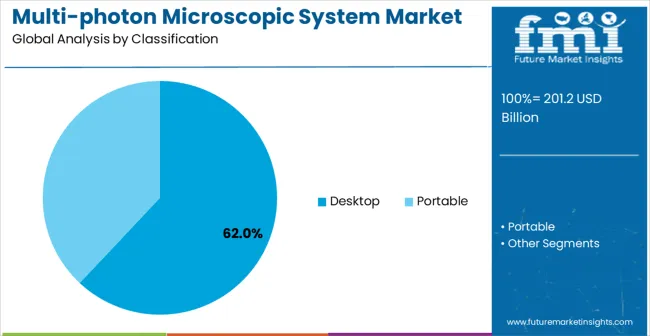
The desktop segment is projected to account for 62.0% of the multi-photon microscopic system market in 2025, reaffirming its position as the leading classification category. Research professionals increasingly utilize desktop multi-photon microscopic systems for their superior stability, proven imaging performance, and convenience in laboratory research applications across biomedical institutions, pharmaceutical companies, and academic research centers. Desktop system technology's established imaging capabilities and consistent performance output directly address the research requirements for reliable high-resolution imaging and operational efficiency in controlled laboratory environments.
This classification segment forms the foundation of modern microscopy research operations, as it represents the system type with the greatest imaging stability and established market demand across multiple research categories and laboratory requirements. Research facility investments in enhanced desktop microscopy technologies and automation systems continue to strengthen adoption among research professionals. With researchers prioritizing consistent imaging performance and proven research reliability, desktop systems align with both research quality objectives and laboratory operational requirements, making them the central component of comprehensive biological research strategies.
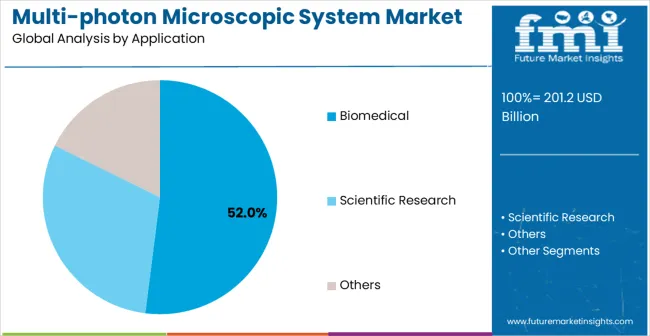
Biomedical applications are projected to represent 52.0% of multi-photon microscopic system demand in 2025, highlighting their critical role as the primary application market for advanced imaging equipment in medical research, drug discovery, and clinical investigation facilities. Biomedical researchers prefer multi-photon microscopic systems for their exceptional deep tissue imaging capabilities, superior cellular visualization, and ability to provide non-invasive biological analysis while maintaining sample integrity and research validity. Positioned as essential equipment for modern biomedical research, multi-photon microscopic systems offer both imaging advantages and research benefits.
The segment is supported by continuous growth in medical research funding and the growing availability of specialized imaging technologies that enable effective biological investigation with enhanced imaging depth and improved research outcomes. Biomedical research institutions are investing in advanced microscopy systems to support cutting-edge research and discovery for demanding medical research standards. As personalized medicine advances and biological research complexity increases, biomedical applications will continue to dominate the end-user market while supporting advanced imaging utilization and medical research innovation strategies.
The market is advancing steadily due to increasing demand for advanced biological imaging and growing adoption of sophisticated microscopy technologies that provide enhanced tissue penetration and superior image quality across diverse life sciences research and biomedical investigation applications. The market faces challenges, including high system costs, technical complexity requirements, and the need for specialized operator training investments. Innovation in laser technology integration and automated imaging systems continues to influence product development and market expansion patterns.
The growing adoption of portable system configurations and enhanced laser technologies is enabling microscopy manufacturers to produce premium multi-photon microscopic systems with superior imaging capabilities, enhanced portability characteristics, and advanced operational flexibility. Advanced imaging systems provide improved research versatility while allowing more efficient sample analysis and consistent output across various biological specimens and research conditions. Manufacturers are increasingly recognizing the competitive advantages of advanced imaging capabilities for product differentiation and premium market positioning in demanding research segments.
Modern multi-photon microscopic system producers are incorporating artificial intelligence and automated analysis technologies to enhance imaging efficiency, improve data processing, and ensure consistent performance delivery to research professionals and biomedical investigators. These technologies improve research productivity while enabling new applications, including automated image analysis and real-time data processing. Advanced AI integration also allows manufacturers to support premium positioning and research excellence beyond traditional microscopy system capabilities.
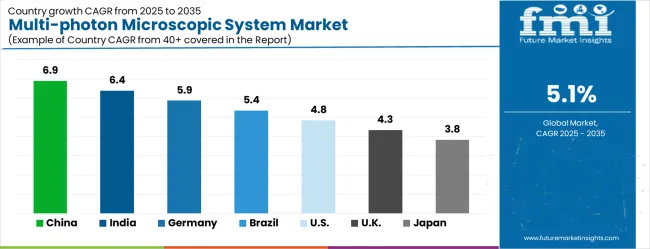
| Country | CAGR (2025-2035) |
|---|---|
| China | 6.9% |
| India | 6.4% |
| Germany | 5.9% |
| Brazil | 5.4% |
| USA | 4.8% |
| UK | 4.3% |
| Japan | 3.8% |
The market is experiencing steady growth globally, with China leading at a 6.9% CAGR through 2035, driven by the expanding life sciences research industry, growing biotechnology sector development, and significant investment in advanced microscopy infrastructure. India follows at 6.4%, supported by large-scale research institution expansion, emerging biotechnology facilities, and growing domestic demand for advanced imaging technologies and scientific equipment. Germany shows growth at 5.9%, focusing technological innovation and precision microscopy development. Brazil records 5.4%, focusing on research infrastructure expansion and scientific equipment modernization. The USA demonstrates 4.8% growth, prioritizing advanced microscopy technologies and high-performance imaging solutions. The UK exhibits 4.3% growth, focusing research capabilities and quality microscopy system adoption. Japan shows 3.8% growth, supported by precision microscopy manufacturing excellence and advanced imaging technology innovation.
The report covers an in-depth analysis of 40+ countries; top-performing countries are highlighted below.
China is projected to record a CAGR of 6.9% from 2025 to 2035, driven by expanding biomedical research, neurobiology studies, and advanced imaging applications. Multi-photon microscopic systems are highly valued for deep tissue imaging, live cell imaging, and high-resolution 3D visualization. Chinese research institutes and pharmaceutical companies are increasing investment in advanced microscopy to support neuroscience, regenerative medicine, and cellular biology. Government initiatives for life sciences research and expansion of biotech hubs enhance adoption. Collaborations between universities and imaging system manufacturers are fostering technological innovation. Rising funding for cancer research and brain mapping projects also fuels demand. China’s growing academic and commercial research infrastructure supports long-term market expansion in this segment.
India is expected to grow at a CAGR of 6.4% during 2025–2035, driven by rising investments in biomedical research, academic research facilities, and pharmaceutical R&D. Multi-photon microscopic systems are increasingly valued for their ability to provide detailed imaging for cellular and molecular studies. Indian research institutions and hospitals are adopting advanced imaging systems to improve research capabilities in neurobiology, oncology, and developmental biology. Government initiatives such as the Biotechnology Industry Research Assistance Council (BIRAC) support infrastructure expansion. Collaborations between academic institutions and microscopy manufacturers enhance access to advanced technologies. Demand is also fueled by growth in private research laboratories and pharmaceutical companies focusing on advanced imaging applications.
Germany is projected to grow at a CAGR of 5.9% from 2025 to 2035, supported by high adoption of advanced imaging systems in biomedical research, clinical diagnostics, and academic studies. Multi-photon microscopy is widely used for high-resolution imaging of tissues, organs, and live cells. German manufacturers emphasize high-precision systems, integration of AI in imaging, and compliance with EU quality standards. Demand is driven by strong government support for scientific research, growing investment in neuroscience, and expansion of imaging core facilities in universities and hospitals. Adoption is particularly high in translational research and pharmaceutical development projects. Germany’s leadership in precision microscopy constant demand growth.
Brazil is forecasted to grow at a CAGR of 5.4% between 2025 and 2035, supported by expansion in biomedical research, clinical applications, and academic institutions. Multi-photon microscopic systems are increasingly used in neuroscience, cancer research, and developmental biology due to their ability to perform deep tissue imaging with high resolution. Local manufacturers focus on cost-efficient solutions while importing advanced systems for cutting-edge research. Demand is supported by growth in research institutes, expansion of academic programs in life sciences, and government investments in healthcare and diagnostics. Collaborations with global microscopy manufacturers enhance capabilities. Increasing academic research in neuroscience and regenerative medicine drives market growth.
The United States is projected to grow at a CAGR of 4.8% during 2025–2035, driven by strong demand from academic research facilities, pharmaceutical R&D, and clinical laboratories. Multi-photon microscopic systems are valued for deep tissue imaging, live-cell studies, and high-precision diagnostics. U.S. manufacturers focus on innovation in optics, AI-assisted imaging, and compact, high-performance designs. Growth is supported by expanding neuroscience research programs, investments in regenerative medicine, and rising demand for advanced imaging in pharmaceutical development. Adoption in clinical research centers and universities is increasing. Collaborations with technology providers enhance system capabilities. Government funding for biomedical imaging projects sustains market expansion.
The United Kingdom is forecasted to grow at a CAGR of 4.3% between 2025 and 2035, driven by growth in academic research, clinical diagnostics, and pharmaceutical studies. Multi-photon microscopic systems are valued for high-resolution imaging capabilities and compatibility with advanced experimental protocols. UK research institutions and hospitals are adopting such systems to strengthen biomedical imaging, neurobiology research, and cancer diagnostics. Manufacturers focus on producing versatile systems that meet stringent regulatory standards. Growth is supported by public and private sector funding in life sciences, expansion of research laboratories, and increasing adoption of advanced imaging techniques in clinical studies. Collaborations with international suppliers enhance system accessibility and innovation.
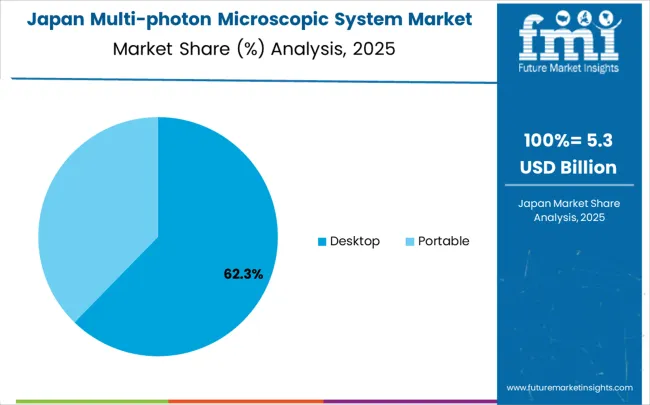
Japan is projected to grow at a CAGR of 3.8% from 2025 to 2035, supported by advanced life sciences research, robust R&D infrastructure, and strong healthcare innovation. Multi-photon microscopic systems are widely applied in neuroscience, developmental biology, and live-cell imaging. Japanese manufacturers focus on precision manufacturing, system reliability, and compliance with strict safety standards. Growth is driven by expanding neuroscience research, increasing adoption of live-cell imaging in drug discovery, and public health initiatives. Academic and research institutes are increasingly investing in advanced microscopy technologies. Collaborations with global microscopy firms strengthen Japan’s capability in high-resolution imaging systems.
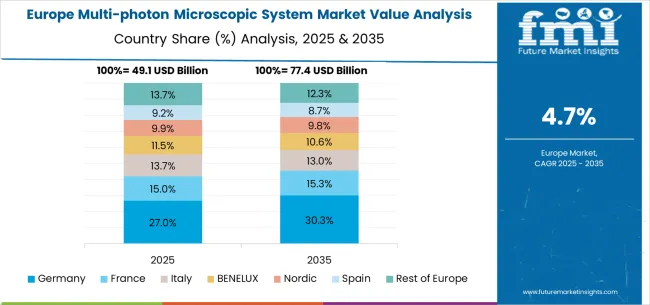
The market in Europe is projected to grow from USD 44.3 billion in 2025 to USD 72.8 billion by 2035, registering a CAGR of 5.1% over the forecast period. Germany is expected to maintain its leadership position with a 24.0% market share in 2025, declining slightly to 23.5% by 2035, supported by its strong research industry, advanced microscopy facilities, and comprehensive scientific equipment supply network serving major European markets.
France follows with an 18.5% share in 2025, projected to reach 18.8% by 2035, driven by robust demand for multi-photon microscopic systems in biomedical research, academic institutions, and scientific equipment applications, combined with established research traditions incorporating advanced microscopy technologies. The United Kingdom holds a 16.0% share in 2025, expected to decrease to 15.7% by 2035, supported by strong research sector demand but facing challenges from competitive pressures and research funding constraints. Italy commands a 14.0% share in 2025, projected to reach 14.2% by 2035, while Spain accounts for 12.5% in 2025, expected to reach 12.8% by 2035. The Netherlands maintains a 4.5% share in 2025, growing to 4.7% by 2035. The Rest of Europe region, including Nordic countries, Eastern Europe, Portugal, Belgium, Switzerland, and Austria, is anticipated to gain momentum, expanding its collective share from 10.5% to 10.3% by 2035, attributed to increasing adoption of advanced research technologies in Nordic countries and growing microscopy activities across Eastern European markets implementing research modernization programs.
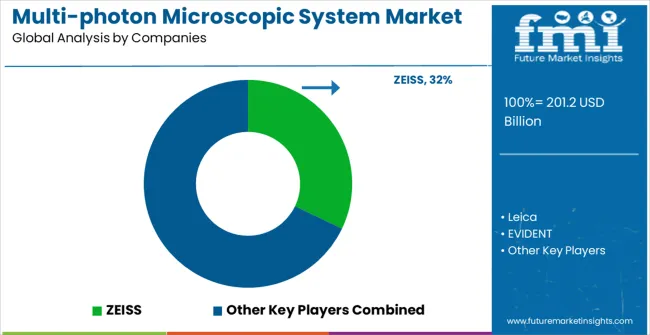
The market is highly competitive, driven by optical performance, imaging depth, and adaptability for advanced biomedical research. ZEISS, Leica, and Nikon Instruments dominate with high precision systems that deliver superior resolution, deep tissue imaging, and robust integration with research workflows. Their competitive edge lies in decades of optical innovation, extensive service networks, and strong brand credibility. Product brochures highlight advanced laser scanning capabilities, customizable imaging modes, and compatibility with diverse biological applications, appealing to research institutions and clinical laboratories worldwide.
Olympus, Bruker, and EVIDENT compete through modular systems that balance high performance with cost efficiency. Olympus focuses on versatility and ergonomic design, while Bruker emphasizes high speed imaging and integration with multimodal systems. EVIDENT differentiates with compact solutions designed for specialized life science applications, offering reliability in both academic and industrial research settings. Thorlabs enhances competition by providing adaptable components and turnkey systems tailored to laboratory-specific needs, targeting institutions that require customization and flexibility.
Beijing Chaoweijing Biological Technology strengthens its position through localized production, competitive pricing, and targeted solutions for emerging markets. Its offerings highlight easy integration, operational stability, and strong post-sale support. Competition in this market is defined by optical resolution, imaging depth, customization, and technical service. Leading firms invest in innovation such as adaptive optics, expanded wavelength capability, and software integration, while regional players focus on affordability, customization, and rapid delivery. Product brochures emphasize imaging precision, system adaptability, and user-friendly operation, reflecting the dynamic competitive landscape of the multi photon microscopic system market.
| Items | Values |
|---|---|
| Quantitative Units (2025) | USD 201.2 billion |
| Classification | Portable, Desktop, Others |
| Application | Biomedical, Scientific Research |
| Regions Covered | North America, Europe, East Asia, South Asia & Pacific, Latin America, Middle East & Africa |
| Countries Covered | United States, Canada, United Kingdom, Germany, France, China, Japan, South Korea, India, Brazil, Australia and 40+ countries |
| Key Companies Profiled | ZEISS, Leica, EVIDENT, Thorlabs, Bruker, and Nikon Instruments |
| Additional Attributes | Dollar sales by classification and application category, regional demand trends, competitive landscape, technological advancements in imaging systems, laser innovation, software development, and research optimization |
The global multi-photon microscopic system market is estimated to be valued at USD 201.2 billion in 2025.
The market size for the multi-photon microscopic system market is projected to reach USD 330.8 billion by 2035.
The multi-photon microscopic system market is expected to grow at a 5.1% CAGR between 2025 and 2035.
The key product types in multi-photon microscopic system market are desktop and portable.
In terms of application, biomedical segment to command 52.0% share in the multi-photon microscopic system market in 2025.






Our Research Products

The "Full Research Suite" delivers actionable market intel, deep dives on markets or technologies, so clients act faster, cut risk, and unlock growth.

The Leaderboard benchmarks and ranks top vendors, classifying them as Established Leaders, Leading Challengers, or Disruptors & Challengers.

Locates where complements amplify value and substitutes erode it, forecasting net impact by horizon

We deliver granular, decision-grade intel: market sizing, 5-year forecasts, pricing, adoption, usage, revenue, and operational KPIs—plus competitor tracking, regulation, and value chains—across 60 countries broadly.

Spot the shifts before they hit your P&L. We track inflection points, adoption curves, pricing moves, and ecosystem plays to show where demand is heading, why it is changing, and what to do next across high-growth markets and disruptive tech

Real-time reads of user behavior. We track shifting priorities, perceptions of today’s and next-gen services, and provider experience, then pace how fast tech moves from trial to adoption, blending buyer, consumer, and channel inputs with social signals (#WhySwitch, #UX).

Partner with our analyst team to build a custom report designed around your business priorities. From analysing market trends to assessing competitors or crafting bespoke datasets, we tailor insights to your needs.
Supplier Intelligence
Discovery & Profiling
Capacity & Footprint
Performance & Risk
Compliance & Governance
Commercial Readiness
Who Supplies Whom
Scorecards & Shortlists
Playbooks & Docs
Category Intelligence
Definition & Scope
Demand & Use Cases
Cost Drivers
Market Structure
Supply Chain Map
Trade & Policy
Operating Norms
Deliverables
Buyer Intelligence
Account Basics
Spend & Scope
Procurement Model
Vendor Requirements
Terms & Policies
Entry Strategy
Pain Points & Triggers
Outputs
Pricing Analysis
Benchmarks
Trends
Should-Cost
Indexation
Landed Cost
Commercial Terms
Deliverables
Brand Analysis
Positioning & Value Prop
Share & Presence
Customer Evidence
Go-to-Market
Digital & Reputation
Compliance & Trust
KPIs & Gaps
Outputs
Full Research Suite comprises of:
Market outlook & trends analysis
Interviews & case studies
Strategic recommendations
Vendor profiles & capabilities analysis
5-year forecasts
8 regions and 60+ country-level data splits
Market segment data splits
12 months of continuous data updates
DELIVERED AS:
PDF EXCEL ONLINE
System-On-Package Market Size and Share Forecast Outlook 2025 to 2035
Systems Administration Management Tools Market Size and Share Forecast Outlook 2025 to 2035
Systemic Sclerosis Treatment Market - Trends & Forecast 2025 to 2035
System on Module Market Growth – Trends & Forecast 2025 to 2035
SLE Drugs Market Insights - Growth & Forecast 2025 to 2035
Systemic Mastocytosis Treatment Market
Systemic Infection Treatment Market
5G System Integration Market Insights - Demand & Growth Forecast 2025 to 2035
VRF Systems Market Growth - Trends & Forecast 2025 to 2035
Rail System Dryer Market Size and Share Forecast Outlook 2025 to 2035
HVAC System Analyzer Market Size and Share Forecast Outlook 2025 to 2035
DWDM System Market Analysis by Services, Product, Vertical, and Region – Growth, Trends, and Forecast from 2025 to 2035
Brake System Market Size and Share Forecast Outlook 2025 to 2035
Cloud Systems Management Software Market Size and Share Forecast Outlook 2025 to 2035
Hi-Fi Systems Market Size and Share Forecast Outlook 2025 to 2035
X-ray System Market Analysis - Size, Share, and Forecast 2025 to 2035
Power System Simulator Market Growth - Trends & Forecast 2025 to 2035
Cough systems Market
Atomic System Clocks Market Forecast and Outlook 2025 to 2035
Closed System Transfer Devices Market Insights – Industry Trends & Forecast 2024-2034

Thank you!
You will receive an email from our Business Development Manager. Please be sure to check your SPAM/JUNK folder too.
Chat With
MaRIA